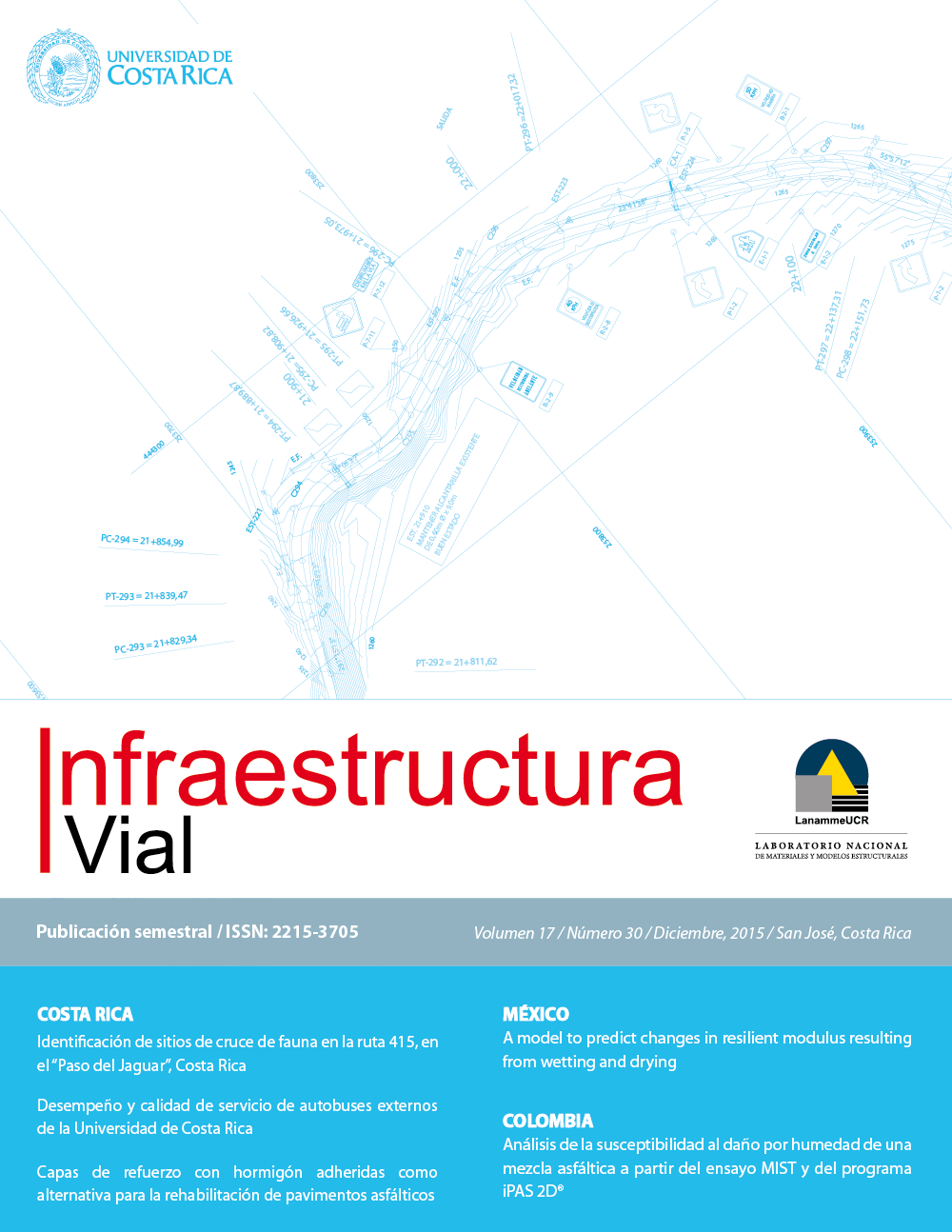Abstract
Moisture Damage is one of the most common problems in asphalt pavements roads in tropical countries and in areas exposed to prolonged periods of rain. This research presents the results of moisture damage in a dense asphaltic mixture, which was designed by the Superpave® methodology and manufactured with eight types of asphalt, subjected to a controlled process of oxidation. In addition, the results of the performance of the asphalt mixture and their relation with moisture damage in Moisture Induced Sensitivity Test-MIST and its analysis using the iPAS 2D® software, which was developed by the MARC Group from the University of Wisconsin-Madison and led by the Professor Hussain Bahia. The results indicate a higher loss of tensile strength when the mixtures are tested with the MIST test compared with the Tensile Strength Ratio-TSR test. Similarly, the images analysis shows the evolution of loss of contact of the aggregates according to the different periods of oxidation of the asphalts and its relation with the MIST analysis.
References
ASTM, A., Test, W. A., Test, C. S., & Test, A. R. (1950). American Society for Testing and Materials (ASTM).
American Association of State Highway and Transportation Officials-AASHTO Standards
Buchanan, M. S., & Moore, V. M. (2005). Laboratory accelerated stripping simulator for hot mix asphalt (No. FHWA/MS-DOT-RD-04-167,).
Chen, X., & Huang, B. (2008). Evaluation of moisture damage in hot mix asphalt using simple performance and superpave indirect tensile tests. Construction and Building Materials, 22(9), 1950-1962.
Cubillos Carlos & Nuñez Camila. Análisis de la susceptibilidad al daño por humedad de una mezcla asfáltica para rodadura empleando asfaltos sumergidos. Pontificia Universidad Javerina. 2014.
Figueroa, A., Velasquez, R., Reyes, F., & Bahia, H. (2013). Effect of Water Conditioning for Extended Periods on the Properties of Asphalt Binders.Transportation Research Record: Journal of the Transportation Research Board, (2372), 34-45.
Instituto Nacional de Vías –INVIAS –Normas 2007.Colombia.
Kanitpong, K., & Bahia, H. (2005). Relating adhesion and cohesion of asphalts to the effect of moisture on laboratory performance of asphalt mixtures. Transportation Research Record: Journal of the Transportation Research Board, (1901), 33-43.
Kennedy, T. W.; Roberts, F. L.; and Anagnos, J. N. (1984). Research Report 253-5, Center for Transportation Research, University of Texas at Austin.
Lottman, R. P. (1971). The moisture mechanism that causes asphalt stripping in asphaltic pavement mixtures.
Masad, E., Muhunthan, B., Shashidhar, N., & Harman, T. (1999a). Internal structure characterization of asphalt concrete using image analysis. Journal of computing in civil engineering, 13(2), 88-95.
Masad, E., Muhunthan, B., Shashidhar, N., & Harman, T. (1999b). Quantifying laboratory compaction effects on the internal structure of asphalt concrete.Transportation Research Record: Journal of the Transportation Research Board, (1681), 179-185.
Sefidmazgi, N. R., Tashman, L., & Bahia, H. (2012). Internal structure characterization of asphalt mixtures for rutting performance using imaging analysis. Road materials and pavement design, 13(sup1), 21-37.
Solaimanian, M., Harvey, J., Tahmoressi, M., & Tandon, V. (2003, February). Test methods to predict moisture sensitivity of hot-mix asphalt pavements. In Transportation Research Board National Seminar. San Diego, California (pp. 77-110).
Tunnicliff, D. G.; and Root, R. E. (1984). “Use of Anti-Stripping Additives in Asphaltic Concrete Mixtures”. NCHRP Report 274, Laboratory Phase, TRB, National Research Council, Washington, D.C.
Xinjun Li, Nelson Gibson, Evaluation Moisture Induced Sensitivity Test (MIST) Device: Comparison and Contrast with AASHTO T 283, FHWA, Draft Report.2010.


